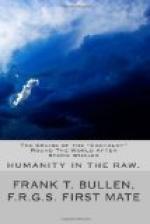After a few days of our present furious rate of speed, I came on deck one morning, and instantly recognized an old acquaintance. Right ahead, looking nearer than I had ever seen it before, rose the towering mass of Tristan d’Acunha, while farther away, but still visible, lay Nightingale and Inaccessible Islands. Their aspect was familiar, for I had sighted them on nearly every voyage I had made round the Cape, but I had never seen them so near as this. There was a good deal of excitement among us, and no wonder. Such a break in the monotony of our lives as we were about to have was enough to turn our heads. Afterwards, we learned to view these matters in a more philosophic light; but now, being new and galled by the yoke, it was a different thing. Near as the island seemed, it was six hours before we got near enough to distinguish objects on shore. I have seen the top of Tristan peeping through a cloud nearly a hundred miles away, for its height is tremendous. St. Helena looks a towering, scowling mass when you approach it closely but Tristan d’Acunha is far more imposing, its savage-looking cliffs seeming to sternly forbid the venturesome voyager any nearer familiarity with their frowning fastnesses. Long before we came within working distance of the settlement, we were continually passing broad patches of kelp (fucus GIGANTEA), whose great leaves and cable-laid stems made quite reef-like breaks in the heaving waste of restless sea. Very different indeed were these patches of marine growth from the elegant wreaths of the Gulf-weed with which parts of the North Atlantic are so thickly covered. Their colour was deep brown, almost black is some cases, and the size of many of the leaves amazing, being four to five feet long, by a foot wide, with stalks as thick as one’s arm. They have their origin around these storm-beaten rocks, which lie scattered thinly over the immense area of the Southern Ocean, whence they are torn, in masses like those we saw, by every gale, and sent wandering round the world.
When we arrived within about three miles of the landing-place, we saw a boat coming off, so we immediately hove-to and awaited her arrival. There was no question of anchoring; indeed, there seldom is in these vessels, unless they are going to make a long stay, for they are past masters in the art of “standing off and on.” The boat came alongside—a big, substantially-built craft of the whale-boat type, but twice the size—manned by ten sturdy-looking fellows, as unkempt and wild-looking as any pirates. They were evidently put to great straits for clothes, many curious makeshifts being noticeable in their rig, while it was so patched with every conceivable kind of material that it was impossible to say which was the original or “standing part.” They brought with them potatoes, onions, a few stunted cabbages, some fowls, and a couple of good-sized pigs, at the sight of which good things our eyes glistened and our mouths watered. Alas! none of the cargo of that boat ever reached our hungry stomachs. We were not surprised, having anticipated that every bit of provision would be monopolized by our masters; but of course we had no means of altering such a state of things.




